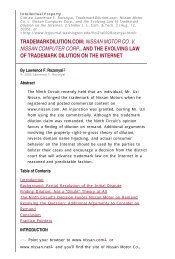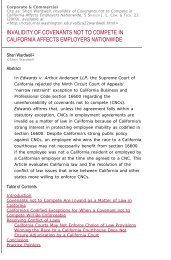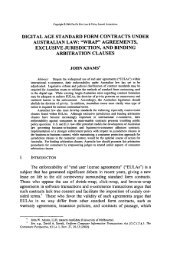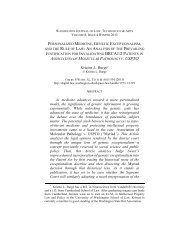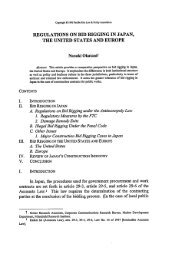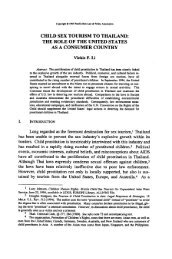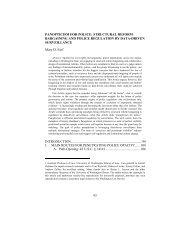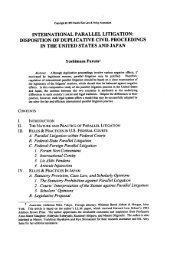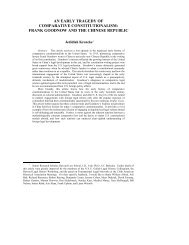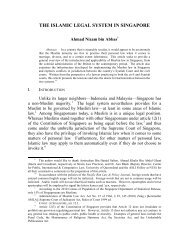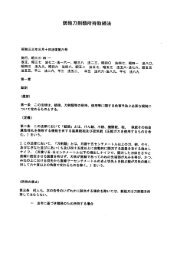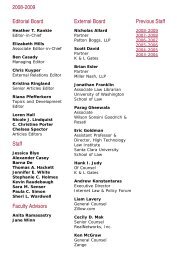Rule of Law and Commercial Litigation in Myanmar, The
Rule of Law and Commercial Litigation in Myanmar, The
Rule of Law and Commercial Litigation in Myanmar, The
You also want an ePaper? Increase the reach of your titles
YUMPU automatically turns print PDFs into web optimized ePapers that Google loves.
Copyright C 2000 Pacific Rim <strong>Law</strong> & Policy Journal Association<br />
THE RULE OF LAW AND COMMERCIAL LITIGATION<br />
IN MYANMAR<br />
Alec Christie t<br />
Abstract: After nearly thirty years <strong>of</strong> self imposed isolation, <strong>Myanmar</strong> has reemerged<br />
as a significant potential dest<strong>in</strong>ation for foreign <strong>in</strong>vestment. One <strong>of</strong> the key<br />
attractions <strong>of</strong> <strong>Myanmar</strong> as a dest<strong>in</strong>ation for foreign <strong>in</strong>vestment is its legal system <strong>and</strong><br />
historical commitment to the rule <strong>of</strong> law. With ASEAN membership <strong>and</strong> <strong>in</strong>creas<strong>in</strong>g<br />
levels <strong>of</strong> foreign <strong>in</strong>vestment <strong>in</strong> <strong>Myanmar</strong>, use <strong>of</strong> its legal system by foreign <strong>in</strong>vestors <strong>and</strong><br />
their counsel has grown. <strong>The</strong> aim <strong>of</strong> this article is to outl<strong>in</strong>e, for both <strong>in</strong>vestors <strong>and</strong> legal<br />
pr<strong>of</strong>essionals <strong>in</strong> other countries throughout the region, <strong>Myanmar</strong>'s legal system <strong>and</strong> its<br />
practical operation <strong>in</strong> the area <strong>of</strong> commercial litigation, <strong>in</strong>clud<strong>in</strong>g the enforcement <strong>of</strong><br />
foreign judgments <strong>and</strong> arbitral awards.<br />
I. INTRODUCTION<br />
S<strong>in</strong>ce ga<strong>in</strong><strong>in</strong>g <strong>in</strong>dependence from Great Brita<strong>in</strong> <strong>in</strong> 1948, the Union <strong>of</strong><br />
<strong>Myanmar</strong>, formerly Burma, 1 has seen its economy move from a marketoriented<br />
system to a socialist system <strong>and</strong>, <strong>in</strong> 1988, back to a market-oriented<br />
economic system. After ga<strong>in</strong><strong>in</strong>g <strong>in</strong>dependence, the country was managed as<br />
a market economy, with the private sector occupy<strong>in</strong>g an important role.<br />
However, after the assumption <strong>of</strong> power by the Revolutionary Government<br />
<strong>in</strong> 1962, a centrally planned economy was adopted under a policy called the<br />
"Burmese Way to Socialism." <strong>The</strong> new socialist government led to the<br />
effective isolation <strong>of</strong> the country <strong>and</strong> a lack <strong>of</strong> <strong>in</strong>formation <strong>and</strong> analysis<br />
outside <strong>of</strong> the country regard<strong>in</strong>g the structure <strong>and</strong> operation <strong>of</strong> <strong>Myanmar</strong>'s<br />
legal system. 2<br />
Today, <strong>Myanmar</strong>'s economy is aga<strong>in</strong> market-oriented <strong>and</strong> has<br />
successfully attracted foreign <strong>in</strong>vestment. In September 1988, rebellion<br />
aga<strong>in</strong>st the Revolutionary Government led to a military coup <strong>in</strong> which the<br />
State <strong>Law</strong> <strong>and</strong> Order Restoration Council ("SLORC") seized power. <strong>The</strong><br />
SLORC <strong>of</strong>ficially ab<strong>and</strong>oned the socialist economic system <strong>and</strong> redirected<br />
<strong>Myanmar</strong> towards a market-oriented economy, allow<strong>in</strong>g the private sector to<br />
t Alec Christie is an Australian qualified lawyer with extensive legal experience <strong>in</strong> the region.<br />
S<strong>in</strong>ce June 1995, when he opened LWA Consultants, he has been permanently resident <strong>in</strong> <strong>Myanmar</strong> <strong>and</strong><br />
has advised on, among other th<strong>in</strong>gs, most <strong>of</strong> the major <strong>in</strong>frastructure projects <strong>in</strong> the country <strong>and</strong> the<br />
establishment <strong>and</strong> ongo<strong>in</strong>g operations <strong>of</strong> m<strong>in</strong><strong>in</strong>g jo<strong>in</strong>t ventures, energy projects, f<strong>in</strong>ance, <strong>and</strong> security<br />
issues <strong>and</strong> residential, hotel, <strong>and</strong> <strong>of</strong>fice developments.<br />
Burma was the name given to the country <strong>in</strong> colonial times by the British.<br />
For the impact <strong>of</strong> this period on <strong>Myanmar</strong>'s legal system, see U MAUNG MAUNG Kyt, A NEW<br />
APPROACH TO LAW AND LIFE IN BURMA 73-75, 99-112 (3d. 1968).
PACIFIC RIM LAW & POLICY JOURNAL<br />
VOL. 10 No. I<br />
develop alongside the State sector. <strong>The</strong> State Peace <strong>and</strong> Development<br />
Council ("SPDC") has cont<strong>in</strong>ued this push towards a market economy.' As<br />
a result, trade opportunities are now available to both domestic <strong>and</strong> foreign<br />
private entrepreneurs. <strong>Myanmar</strong> has been particularly successful <strong>in</strong> its<br />
efforts to attract foreign <strong>in</strong>vestment. It is expected that foreign <strong>in</strong>vestment <strong>in</strong><br />
<strong>Myanmar</strong> will <strong>in</strong>crease for several reasons: <strong>Myanmar</strong>'s membership <strong>in</strong> the<br />
Association <strong>of</strong> Southeast Asian Nations ("ASEAN"); its English-based legal<br />
system; its historical commitment to the rule <strong>of</strong> law; <strong>and</strong> its significant,<br />
untapped natural <strong>and</strong> human resources.<br />
<strong>The</strong> aim <strong>of</strong> this article is to outl<strong>in</strong>e <strong>Myanmar</strong>'s legal system <strong>and</strong> its<br />
practical operation <strong>in</strong> the area <strong>of</strong> commercial litigation. Part II provides a<br />
historical background <strong>of</strong> <strong>Myanmar</strong>'s legal system. Part III outl<strong>in</strong>es<br />
<strong>Myanmar</strong>'s legal system as it exists today. Part IV discusses the country's<br />
civil procedure requirements. Part V exam<strong>in</strong>es the enforceability <strong>of</strong> foreign<br />
judgments, <strong>and</strong> Part VI describes the enforceability <strong>of</strong> foreign arbitral<br />
awards <strong>in</strong> <strong>Myanmar</strong>.<br />
II.<br />
MYANMAR GOVERNMENTS AND CONTINUITY OF THE LAW<br />
In order to appreciate the current structure <strong>of</strong> <strong>Myanmar</strong>'s legal system,<br />
it is necessary to briefly recount the types <strong>of</strong> governments <strong>in</strong> <strong>Myanmar</strong> s<strong>in</strong>ce<br />
colonial times <strong>and</strong> their impact on the cont<strong>in</strong>uity <strong>of</strong> <strong>Myanmar</strong> laws. 4<br />
A. Colonial Governments<br />
On May 1, 1897, Burma became a Lieutenant-Governorship as a<br />
prov<strong>in</strong>ce <strong>of</strong> Brita<strong>in</strong>'s "Indian Empire." 5 <strong>The</strong> Lieutenant-Govemor was the<br />
head <strong>of</strong> the adm<strong>in</strong>istration <strong>of</strong> Burma <strong>and</strong> exercised the powers <strong>of</strong> local<br />
government. 6 <strong>The</strong> Legislative Council assisted the Lieutenant-Governor <strong>in</strong><br />
his duties by prepar<strong>in</strong>g <strong>and</strong> pass<strong>in</strong>g legislation regard<strong>in</strong>g local <strong>and</strong> prov<strong>in</strong>cial<br />
requirements. 7 Legislation became law if it received the sanction <strong>of</strong> the<br />
' <strong>The</strong> change from the State <strong>Law</strong> <strong>and</strong> Order Restoration Council ("SLORC') to the State Peace <strong>and</strong><br />
Development Council ("SPDC") occurred on November 15, 1997, with the aim <strong>of</strong> develop<strong>in</strong>g a<br />
"democratic system <strong>in</strong> the State <strong>and</strong> build a new peaceful, tranquil, <strong>and</strong> modem developed nation."<br />
4 For a comprehensive review <strong>of</strong> <strong>Myanmar</strong> government s<strong>in</strong>ce colonial times, see Kyaw Se<strong>in</strong>, A<br />
Brief Legal History <strong>of</strong><strong>Myanmar</strong>, I LAW JOURNAL, June 1999; A. EGGAR, THE LAWS OF INDIA AND BURMA<br />
(Rangoon 1929).<br />
' SIR J.G. SCOTT, BURMA: A HANDBOOK OF PRACTICAL INFORMATION 147-48 (De La More Press<br />
ed., 3d ed. 1921).<br />
6 Id. at 148.<br />
7 Id.
DECEMBER 2000<br />
COMMERCIAL LITIGA TION IN MYANMAR<br />
Governor General <strong>of</strong> British India.! In addition to local legislation, all <strong>of</strong> the<br />
Indian Statutes enacted dur<strong>in</strong>g this period applied to the "prov<strong>in</strong>ce <strong>of</strong><br />
Burma." 9<br />
In 1935, Burma separated from British India but did not ga<strong>in</strong> much<br />
<strong>in</strong>dependent sovereignty. Burma rema<strong>in</strong>ed a British colony but ga<strong>in</strong>ed the<br />
power to make laws <strong>in</strong> the Burma Legislature." <strong>The</strong> Government <strong>of</strong> Burma<br />
Act, however, specifically declared that the Indian Statutes would cont<strong>in</strong>ue<br />
<strong>in</strong> force until altered, repealed or amended by the Legislature." Dur<strong>in</strong>g the<br />
Japanese occupation <strong>of</strong> Burma from 1942 to 1945, the exist<strong>in</strong>g laws <strong>of</strong><br />
Burma, <strong>in</strong>clud<strong>in</strong>g the Indian Acts applicable to Burma, cont<strong>in</strong>ued <strong>in</strong> force. 12<br />
In May 1945, Brita<strong>in</strong> re-occupied Burma <strong>and</strong> revived all laws <strong>and</strong><br />
regulations <strong>in</strong> force prior to the Japanese occupation. 3<br />
B. Governments S<strong>in</strong>ce Independence<br />
Even after Burma became an <strong>in</strong>dependent sovereign state on January<br />
4, 1948, Burma kept <strong>in</strong> place the prior law enacted dur<strong>in</strong>g the colonial times.<br />
Specific legislation m<strong>and</strong>ated that all laws passed prior to January 4, 1948<br />
were to cont<strong>in</strong>ue <strong>in</strong> force until amended or repealed by the new Union<br />
Parliament. 4 Similarly, the law as it existed <strong>in</strong> <strong>Myanmar</strong> immediately prior<br />
to the assumption <strong>of</strong> power by the Revolutionary Council on March 2, 1962,<br />
cont<strong>in</strong>ued <strong>in</strong> force until specifically repealed or amended.' 5 <strong>The</strong> 1974<br />
Constitution also cont<strong>in</strong>ued the pre-1974 laws to the extent that they did not<br />
conflict with the Constitution itself or unless they were expressly repealed or<br />
amended. 1 6 Furthermore, after the State <strong>Law</strong> <strong>and</strong> Order Restoration Council<br />
("SLORC") took power <strong>in</strong> September 1988 <strong>and</strong> ab<strong>and</strong>oned the socialist<br />
economic system by re<strong>in</strong>troduc<strong>in</strong>g a market-oriented economy, all exist<strong>in</strong>g<br />
laws rema<strong>in</strong>ed <strong>in</strong> force until specifically repealed or amended, <strong>in</strong>clud<strong>in</strong>g<br />
laws passed dur<strong>in</strong>g the socialist period. 7 Similarly, on the assumption <strong>of</strong><br />
8 Id.<br />
' To date, the India statutes applied <strong>in</strong> <strong>Myanmar</strong> still carry a reference to the "India Act" reference<br />
number.<br />
0 Government <strong>of</strong> Burma Act (1935) (Myan.).<br />
Id. § 148; see A. EGGAR, DIGEST OF THE GOVERNMENT OF BURMA AcT 15 (Government Pr<strong>in</strong>ters<br />
1962).<br />
2 <strong>The</strong> <strong>Law</strong> Regulat<strong>in</strong>g the Adm<strong>in</strong>istration <strong>of</strong> Burma (1305 M.E.) (Myan.) § 23.<br />
'3 <strong>The</strong> Burma Indemnity <strong>and</strong> Validat<strong>in</strong>g Act (1945) (Myan.).<br />
'4 BURMA CONST. (1947) ch. XIV § 226 (1); <strong>The</strong> Union <strong>of</strong> Burma (Adaptation <strong>of</strong> <strong>Law</strong>s) Order<br />
(1948) (Myan.).<br />
"5 Kyaw Se<strong>in</strong>, supra note 4.<br />
16 BURMA CONST. (1974) art. 202(b).<br />
7 Kyaw Se<strong>in</strong>, supra note 4; Notification <strong>of</strong> the State <strong>Law</strong> <strong>and</strong> Order Restoration Council (No. 6/88,<br />
Sep. 24, 1988)(Myan.)
PACIFIC RIM LAW & POLICY JOURNAL<br />
VOL. 10 ONO. I<br />
power by the State Peace <strong>and</strong> Development Council ("SPDC"), all laws then<br />
<strong>in</strong> force cont<strong>in</strong>ued until specifically repealed or amended. 8<br />
III.<br />
OVERVIEW OF THE CURRENT LEGAL SYSTEM<br />
Today, the legal system <strong>of</strong> the Union <strong>of</strong> <strong>Myanmar</strong> is a unique<br />
comb<strong>in</strong>ation <strong>of</strong> the customary law <strong>of</strong> the family, codified English common<br />
law, local case law, <strong>and</strong> recent <strong>Myanmar</strong> legislation.' 9 Prior to <strong>Myanmar</strong>'s<br />
<strong>in</strong>dependence, Brita<strong>in</strong> implanted the pr<strong>in</strong>ciples <strong>of</strong> English statutory <strong>and</strong><br />
common law <strong>in</strong> <strong>Myanmar</strong> through the Indian Statutes. 20 <strong>The</strong>se codes, based<br />
on English statutory <strong>and</strong> common law, <strong>in</strong>clude the Arbitration Act, the<br />
Companies Act, the Contract Act, the Negotiable Instruments Act, the<br />
Registration Act, the Sale <strong>of</strong> Goods Act, the Transfer <strong>of</strong> Property Act, the<br />
Trusts Act, <strong>and</strong> the Civil <strong>and</strong> Crim<strong>in</strong>al Procedure Codes. 2 '<br />
<strong>Myanmar</strong> courts <strong>in</strong>terpret these codes by look<strong>in</strong>g to Indian <strong>and</strong><br />
English authorities. Indian decisions <strong>in</strong>terpret<strong>in</strong>g these codes <strong>and</strong> English<br />
decisions <strong>in</strong>terpret<strong>in</strong>g equivalent English laws rema<strong>in</strong> extremely persuasive<br />
authority <strong>in</strong> <strong>Myanmar</strong> courts. Similarly, Indian legal texts on the laws<br />
shared by India <strong>and</strong> the former Burma are also persuasive. 22 Where no<br />
statute addresses a particular matter, courts apply <strong>Myanmar</strong>'s general law,<br />
which is based on English common law as adopted <strong>and</strong> <strong>in</strong>terpreted by<br />
21<br />
<strong>Myanmar</strong> courts. Where there is no relevant statutory or general law on<br />
po<strong>in</strong>t, the <strong>Myanmar</strong> Courts are obliged to decide the matter accord<strong>in</strong>g to<br />
justice, equity, <strong>and</strong> good conscience. 24<br />
A. Re-Emphasis on Pre-Independence <strong>Law</strong><br />
Under the SLORC <strong>and</strong> the SPDC, the corporate, commercial, <strong>and</strong><br />
economic laws <strong>of</strong> pre-<strong>in</strong>dependence <strong>Myanmar</strong> have been re-emphasized as<br />
"S <strong>The</strong> Adoption <strong>of</strong> Expressions <strong>Law</strong> (1997) (Myan.).<br />
'9 See U MAUNG MAUNG KYI, supra note 2, ch. VI; MAUNG MAUNG, LAW AND CUSTOM IN BURMA<br />
AND THE BURMESE FAMILY vi., ch. III (Mart<strong>in</strong>us Nijh<strong>of</strong>f 1963).<br />
20 As to the adoption <strong>and</strong> use <strong>of</strong> common law <strong>and</strong> equity <strong>in</strong> <strong>Myanmar</strong>, see U T<strong>in</strong> Eng v. U Ba Yoke<br />
[1957] B.L.R. (H.C.) 341 (Myan.); U MAUNG MAUNG KYI, supra note 2, ch. III.<br />
21 For a discussion <strong>of</strong> the legal system <strong>and</strong> the laws before colonisation, see MR. JUSTICE E. MAUNG,<br />
THE EXPANSION OF BURMESE LAW (1951).<br />
I For example, His Honour U Thaung Se<strong>in</strong> J cites a number <strong>of</strong> India <strong>and</strong> English legal texts <strong>in</strong> Indo<br />
Burma Petroleum Company Limited v. <strong>The</strong> Union <strong>of</strong> Burma, [1961] B.L.R. (H.C.) 145 (Myan.).<br />
23 See Dr. Daw Mya Swe v. <strong>The</strong> Union <strong>of</strong> Burma Airways [1964] B.L.R. (C.C.) 279 (Myan.).<br />
24 U Se<strong>in</strong> v. Daw Mya Aung [1984] B.L.R. 224 (Myan.); <strong>The</strong> Judiciary <strong>Law</strong> 2000 § 2 (No. 5/00)<br />
(Myan.) [here<strong>in</strong>after Judiciary <strong>Law</strong>].
DECEMBER 2000<br />
COMMERCIAL LITIGATION IN MYANMAR<br />
the pillars <strong>of</strong> <strong>Myanmar</strong>'s push towards a market economy. 25 In 1998, the<br />
Office <strong>of</strong> the Attorney General published a comprehensive <strong>and</strong> authoritative<br />
list<strong>in</strong>g <strong>of</strong> the statutes <strong>in</strong> force <strong>in</strong> <strong>Myanmar</strong> as <strong>of</strong> December 31, 1997,<br />
<strong>in</strong>clud<strong>in</strong>g pre- <strong>and</strong> post-<strong>in</strong>dependence legislation. 26 <strong>Myanmar</strong>'s commercial<br />
laws have historically been based on concepts similar to those <strong>of</strong> the<br />
commercial laws <strong>of</strong> Australia, Engl<strong>and</strong>, Hong Kong, Malaysia, S<strong>in</strong>gapore,<br />
<strong>and</strong> other former British colonies <strong>of</strong> the region. <strong>The</strong>se laws, however, are<br />
subject to the <strong>in</strong>terpretation <strong>of</strong> the <strong>Myanmar</strong> courts. 27<br />
As a result <strong>of</strong> the socialist economic system <strong>in</strong> place between 1962<br />
<strong>and</strong> 1988, there is little case law <strong>in</strong>terpret<strong>in</strong>g <strong>Myanmar</strong> statutes. However,<br />
as expected, recent decisions confirmed that pre-1962 case law will be<br />
followed by the courts <strong>of</strong> post-1988 <strong>Myanmar</strong>. 28<br />
B. New <strong>Law</strong>s<br />
S<strong>in</strong>ce 1988, <strong>Myanmar</strong> has promulgated numerous new laws to<br />
encourage foreign <strong>and</strong> local <strong>in</strong>vestment <strong>and</strong> develop the market economy.<br />
Perhaps the most important <strong>of</strong> these new laws, especially for larger foreign<br />
<strong>in</strong>vestors, is the <strong>Myanmar</strong> Foreign Investment <strong>Law</strong> <strong>of</strong> 1988. <strong>The</strong> purpose <strong>of</strong><br />
this law is to <strong>of</strong>fer tax <strong>in</strong>centives <strong>and</strong> exemptions to attract the larger foreign<br />
<strong>in</strong>vestments. 29<br />
C. <strong>The</strong> Adm<strong>in</strong>istration <strong>of</strong> Justice<br />
<strong>Myanmar</strong> courts base the adm<strong>in</strong>istration <strong>of</strong> justice upon the follow<strong>in</strong>g<br />
pr<strong>in</strong>ciples: 3 "<br />
(1) Independence <strong>of</strong> the judiciary;<br />
(2) Protect<strong>in</strong>g <strong>and</strong> safeguard<strong>in</strong>g the <strong>in</strong>terests <strong>of</strong> the people;<br />
z Dr. Tun Sh<strong>in</strong>, <strong>The</strong> Legal Framework <strong>of</strong> <strong>Myanmar</strong>, Address before the Europe/East Asia<br />
Economic Summit <strong>in</strong> S<strong>in</strong>gapore (Sept. 20-22, 1995) <strong>in</strong> GOLDEN MYANMAR, vol. 3 No. 1 1996, at 3; THE<br />
EAST ASIA ANALYTICAL UNIT OF DEPARTMENT OF FOREIGN AFFAIRS AND TRADE OF AUSTRALIA, THE NEW<br />
ASEANS: VIETNAM, BURMA, CAMBODIA AND LAOS 104 (1997).<br />
26 OFFICE OF THE ATrORNEY GENERAL, THE INDEX OF LAWS (1998).<br />
2 See H. Oppenheimer v. M. E. Moola Sons, Ltd. [1929] 7 Ran. 514 (Myan.).<br />
28 U MAUNG MAUNG KYI, supra note 2, at 62-63; For an example <strong>of</strong> star decisis <strong>in</strong> <strong>Myanmar</strong>, see<br />
the reason<strong>in</strong>g <strong>of</strong> the Full Bench <strong>of</strong> the High Court <strong>in</strong> In Re Ma Mya v. Ma <strong>The</strong><strong>in</strong>, I.L.R. 4 Ran. 313<br />
(Myan.).<br />
"' See generally Alec Christie & Suzanne Smith, FOREIGN DIRECT INVESTMENT IN MYANMAR<br />
(1997).<br />
38 <strong>The</strong> Judiciary <strong>Law</strong>, supra note 24, § 2.
PACIFIC RIM LAW & POLICY JOURNAL<br />
VOL. 10 No. I<br />
(3) Educat<strong>in</strong>g the people to underst<strong>and</strong> <strong>and</strong> abide by the law <strong>and</strong><br />
cultivat<strong>in</strong>g the habit <strong>of</strong> abid<strong>in</strong>g by the law;<br />
(4) Work<strong>in</strong>g with<strong>in</strong> the framework <strong>of</strong> law for the settlement <strong>of</strong><br />
cases; 31<br />
(5) Dispens<strong>in</strong>g justice <strong>in</strong> open court, unless otherwise prohibited by<br />
law; <strong>and</strong><br />
(6) Guarantee<strong>in</strong>g, <strong>in</strong> all cases, the right <strong>of</strong> defense <strong>and</strong> the right <strong>of</strong><br />
appeal under the law.<br />
<strong>The</strong> judicial system <strong>in</strong> <strong>Myanmar</strong> is hierarchical. In order <strong>of</strong><br />
importance, the follow<strong>in</strong>g are the various courts <strong>of</strong> <strong>Myanmar</strong>: 3 1<br />
(1) <strong>The</strong> Supreme Court;<br />
(2) Divisional Courts or State Courts (<strong>of</strong> which there are fourteen);<br />
(3) District Courts (<strong>of</strong> which there are sixty-three); <strong>and</strong><br />
(4) Township Courts (<strong>of</strong> which there are 323).<br />
D. <strong>The</strong> Supreme Court<br />
<strong>The</strong> Judiciary <strong>Law</strong> <strong>of</strong> 1988 re-established the Supreme Court as the<br />
highest court <strong>in</strong> <strong>Myanmar</strong>, <strong>and</strong> this was confirmed by the Judiciary <strong>Law</strong><br />
2000. <strong>The</strong> <strong>Myanmar</strong> Supreme Court consists <strong>of</strong> the Chief Justice, two<br />
Deputy-Chief Justices <strong>and</strong> between seven to twelve judges. 33 <strong>The</strong> Supreme<br />
Court Justices are assisted by judicial <strong>of</strong>ficers who undertake research <strong>and</strong><br />
provide other assistance. In addition, law <strong>of</strong>ficers, appo<strong>in</strong>ted by the<br />
Attorney General's <strong>of</strong>fice, act as public prosecutors <strong>in</strong> all <strong>Myanmar</strong> courts.<br />
<strong>The</strong> Supreme Court is responsible for the supervision <strong>of</strong> all other<br />
courts <strong>in</strong> <strong>Myanmar</strong> <strong>and</strong> has jurisdiction to adjudicate the follow<strong>in</strong>g: 34<br />
(1) Civil <strong>and</strong> crim<strong>in</strong>al matters with<strong>in</strong> its orig<strong>in</strong>al jurisdiction;<br />
(2) Appeal hear<strong>in</strong>gs from a decision <strong>of</strong> a Divisional or State Court;<br />
(3) Any order or decision relat<strong>in</strong>g to the legal rights <strong>of</strong> a citizen,<br />
<strong>and</strong> if necessary, amend<strong>in</strong>g or quash<strong>in</strong>g such order;<br />
(4) Cases aga<strong>in</strong>st the judgment, order, or decision <strong>of</strong> any court;<br />
" See also Jiwanram & Rampartap v. Comm'r <strong>of</strong> Income Tax, Burma [1958] B.L.R. (H.C.) 95<br />
(Myan.).<br />
32 Judiciary <strong>Law</strong>, supra note 24, § 12.<br />
3 Id.§3.<br />
'4 Id.§§5,6.
DECEMBER 2000<br />
COMMERCIAL LITIGATION IN MYANMAR<br />
(5) Any judgment, order, or decision <strong>of</strong> any court thatis not <strong>in</strong><br />
accordance with the law;<br />
(6) Admiralty cases; <strong>and</strong><br />
(7) Cases for which it is given jurisdiction under any law.<br />
<strong>The</strong> full bench <strong>of</strong> the Supreme Court, at the discretion <strong>of</strong> the Chief Justice<br />
may review any decision by a s<strong>in</strong>gle Supreme Court judge or a decision<br />
made by a less than full bench. 3 "<br />
E. Additional <strong>Myanmar</strong> Courts<br />
<strong>The</strong> Divisional or State Courts have orig<strong>in</strong>al jurisdiction <strong>in</strong> crim<strong>in</strong>al<br />
<strong>and</strong> civil proceed<strong>in</strong>gs, as well as be<strong>in</strong>g the court <strong>of</strong> first appeal for decisions<br />
made <strong>in</strong> Township Courts. 6 <strong>The</strong> Township <strong>and</strong> District Courts deal ma<strong>in</strong>ly<br />
with petty crim<strong>in</strong>al matters <strong>and</strong> civil matters <strong>of</strong> low monetary value. In<br />
accordance with the directions <strong>of</strong> the Supreme Court, each Divisional, State,<br />
District, <strong>and</strong> Township Court may decide cases with a s<strong>in</strong>gle judge or by a<br />
bench. 7<br />
F. Jurisdiction<br />
In general, <strong>Myanmar</strong> courts have jurisdiction to try all civil suits<br />
aga<strong>in</strong>st all persons with<strong>in</strong> <strong>Myanmar</strong>, local or foreign, other than foreign<br />
sovereigns. 3 " <strong>The</strong> appropriate court <strong>in</strong> which to commence proceed<strong>in</strong>gs<br />
depends on the type <strong>and</strong> value <strong>of</strong> the claim <strong>and</strong> the location <strong>of</strong> the parties or<br />
the location <strong>of</strong> the act <strong>in</strong> question. 39 <strong>Myanmar</strong> courts will uphold choice <strong>of</strong><br />
jurisdiction clauses between parties specify<strong>in</strong>g that a particular <strong>Myanmar</strong><br />
court will hear a given dispute. 4 " Such agreements, <strong>in</strong> which a court outside<br />
<strong>of</strong> <strong>Myanmar</strong> is chosen, will be enforced if they are not contrary to public<br />
35 Id. § 9.<br />
36 Id. §§ 14, 15.<br />
37 Id. §§ 17, 20, 21.<br />
31 BURMA CODE OF CIVIL PROCEDURE [C. Civ. P.] § 86. Regard<strong>in</strong>g actions aga<strong>in</strong>st foreign<br />
sovereigns, see U Zeya v. <strong>The</strong> Secretary <strong>of</strong> State <strong>of</strong> His Britannic Majesty For War Represented By<br />
Headquarters, Burma Comm<strong>and</strong> [ 1949] B.L.R. (H.C.) 402 (Myan.).<br />
19 C. Civ. P. §§ 15-20; see Daw Ky<strong>in</strong> Hla<strong>in</strong>g v. U W<strong>in</strong> Maung [1958] B.L.R. (H.C.) 87 (Myan.); U<br />
Se<strong>in</strong> Hla<strong>in</strong>g v. U Chan Ba Lone [1987] B.L.R. 13 (Myan.). Regard<strong>in</strong>g choice <strong>of</strong>jurisdiction, see Am. Int'l<br />
Underwriters (Myan.) Ltd. v. U Maung San [1961] B.L.R. (H.C.) 41 (Myan.).<br />
I See U Maung San v. Am. Int'l Underwriters (<strong>Myanmar</strong>) Ltd. Rangoon [1962] B.L.R. (C.C.) 191<br />
(Myan.); Steel Brothers & Co. Ltd. v. Y. A. Ganny Sons [1965] (C.C.) 449 (Myan.).
PACIFIC RIM LAW & POLICY JOURNAL<br />
VOL. I10 No. I<br />
policy. However, a clause that excludes the jurisdiction <strong>of</strong> the courts<br />
altogether is illegal <strong>and</strong> void <strong>in</strong> <strong>Myanmar</strong> under the Contract Act. 4<br />
IV.<br />
BRIEF OUTLINE OF CIVIL PROCEDURE IN MYANMAR<br />
<strong>Myanmar</strong>'s legal system is adversarial. Matters are heard before a<br />
judge or bench <strong>of</strong> judges <strong>and</strong> argued by advocates or pleaders. <strong>The</strong> Code <strong>of</strong><br />
Civil Procedure provides the ma<strong>in</strong> source <strong>of</strong> <strong>Myanmar</strong>'s procedural rules<br />
regard<strong>in</strong>g civil litigation. Advocates <strong>and</strong> pleaders also refer to the Courts<br />
Manual <strong>of</strong> 1960 <strong>and</strong> the Evidence Act <strong>of</strong> 1872. Despite its separate<br />
existence, the practices <strong>and</strong> procedures <strong>of</strong> <strong>Myanmar</strong> courts were<br />
significantly <strong>in</strong>fluenced by English practices <strong>and</strong> procedures.<br />
Currently, <strong>Myanmar</strong> does not have a developed dispute resolution<br />
mechanism, apart from arbitration. 42 In particular, unlike the North<br />
American court system, "m<strong>in</strong>i trials," "private courts," <strong>and</strong> compulsory<br />
settlement conferences do not exist <strong>in</strong> <strong>Myanmar</strong>.<br />
A. Parties to a Suit<br />
1. Contract Actions<br />
In a breach <strong>of</strong> contract action the proper pla<strong>in</strong>tiff is the person with<br />
whom or on whose behalf the contract was made or <strong>in</strong> whom the rights<br />
under the contract were vested. 43 If an action is to be brought by several cocontractors<br />
upon a promise made to them jo<strong>in</strong>tly, all the parties should be<br />
jo<strong>in</strong>ed.<br />
<strong>The</strong> proper defendant <strong>in</strong> a contract action is any <strong>of</strong> the follow<strong>in</strong>g: (1)<br />
the person who made the promise, the breach <strong>of</strong> which has led to the action<br />
be<strong>in</strong>g brought; (2) the party who is liable under the contract; or (3) the party<br />
to whom the liability under the contract has passed." When two or more<br />
persons are jo<strong>in</strong>tly <strong>and</strong> severally liable under a contract, all parties must be<br />
jo<strong>in</strong>ed as co-defendants. 4 5 If only one <strong>of</strong> the appropriate parties is sued, that<br />
party may, on application to the court, have the action stayed until all other<br />
relevant persons are jo<strong>in</strong>ed as co-defendants.<br />
4' <strong>The</strong> Contract Act § 28 (Myan.).<br />
42 For a discussion <strong>of</strong> arbitration, see Alec Christie, Arbitration <strong>in</strong> <strong>Myanmar</strong>, INT'L. ARB. L. REV.<br />
(1998).<br />
43 C. Civ. P., ORD. I, R. 1.<br />
4 C. Civ. P., ORD. 1, R. 3.<br />
41 See Daw Aye Mya<strong>in</strong>g v. Daw Hla Kyi [1987] B.L.R. 116 (Myan.).
DECEMBER 2000<br />
COMMERCIAL LITIGATION IN MYANMAR<br />
All objections on the ground <strong>of</strong> non-jo<strong>in</strong>der or misjo<strong>in</strong>der <strong>of</strong> parties<br />
must be made at the earliest possible opportunity. <strong>The</strong>se objections cannot<br />
be made later than the settlement <strong>of</strong> issues, unless the grounds for the<br />
objection have arisen out <strong>of</strong> or subsequent to the settlement <strong>of</strong> issues. 46<br />
2. Tort Actions<br />
In a tort action the proper pla<strong>in</strong>tiff is the person <strong>in</strong>jured by the<br />
wrongdoer or, <strong>in</strong> case <strong>of</strong> death, the person with a vested right to sue. 47<br />
Where several persons are <strong>in</strong>jured by a tort, any one <strong>of</strong> them may sue<br />
without jo<strong>in</strong><strong>in</strong>g the other <strong>in</strong>jured parties. Where there is more than one<br />
pla<strong>in</strong>tiff, one or more <strong>of</strong> them may be authorized by the others to appear,<br />
plead, or act for them <strong>in</strong> any proceed<strong>in</strong>g. 48 This authority must be conferred<br />
<strong>in</strong> writ<strong>in</strong>g, signed by the party or parties giv<strong>in</strong>g it, <strong>and</strong> filed <strong>in</strong> court. 49 <strong>The</strong><br />
same pr<strong>in</strong>ciple also applies to multiple defendants. 50<br />
<strong>The</strong> proper defendant <strong>in</strong> a tort action is the wrongdoer or the person<br />
who is liable for the acts <strong>of</strong> the wrongdoer, such as a vicariously liable<br />
employer. 5 " If several persons jo<strong>in</strong>tly commit a tort, the pla<strong>in</strong>tiff may sue<br />
any <strong>in</strong>dividual tortfeasor <strong>and</strong> is not obligated to jo<strong>in</strong> any other defendants.<br />
B. Institut<strong>in</strong>g Proceed<strong>in</strong>gs <strong>and</strong> Service<br />
Typically, a pla<strong>in</strong>tiff commences a civil action by fil<strong>in</strong>g a pla<strong>in</strong>t 2 that<br />
sets out the claim aga<strong>in</strong>st the defendant. 53 Courts will reject pla<strong>in</strong>ts that do<br />
not state a cause <strong>of</strong> action, undervalue the relief claimed, are barred by law,<br />
or are <strong>in</strong>correctly stamped. 54 When a pla<strong>in</strong>t has been filed, a summons is<br />
served upon the defendant request<strong>in</strong>g the defendant to appear <strong>and</strong> answer<br />
the claim. 5<br />
In civil matters, a summons to commence proceed<strong>in</strong>gs must meet<br />
certa<strong>in</strong> requirements. <strong>The</strong> summons must be signed by a judge, or the<br />
" C. Civ. P., OiD. I, R. 13; see also S.S. Mohideen et al. v. U.P. Narayana Swamy [1967] B.L.R.<br />
(C.C.) 188 (Myan.).<br />
17 C. Civ. P., ORD. I, R. 1.<br />
" See Phu Kyaw Wai v. Ah Se<strong>in</strong> [1958] B.L.R. (H.C.) 353 (Myan.).<br />
49 Civ. P., ORD. I, R. 12.<br />
so Id.<br />
C. Civ. P., ORD. 1, R. 3.<br />
52 "Pla<strong>in</strong>t" is the term used <strong>in</strong> <strong>Myanmar</strong> for a compla<strong>in</strong>t <strong>in</strong> the United States.<br />
13 C. CIV. P. § 26; see C. Civ. P., ORD. IV, R. 1.<br />
5 C. Civ. P., ORD. VII, R. II.; see Daw Th<strong>in</strong> Hla<strong>in</strong>g v. G. Gordh<strong>and</strong>us [1965] B.L.R. (C.C.) 594<br />
(Myan.).<br />
51 C. Civ. P. § 27.
PACIFIC RIM LAW & POLICY JOURNAL<br />
VOL. 10 No. I<br />
judge's representative, <strong>and</strong> sealed by the court prior to service upon the<br />
defendant. 56 <strong>The</strong> summons should also attach a copy <strong>of</strong> the pla<strong>in</strong>t or, if<br />
unavailable, a concise statement <strong>of</strong> the claim aga<strong>in</strong>st the defendant. 57<br />
Service <strong>of</strong> the summons <strong>in</strong> <strong>Myanmar</strong> may be either personal, upon an<br />
agent, or, <strong>in</strong> certa<strong>in</strong> circumstances, by registered mail. 58 In matters aga<strong>in</strong>st a<br />
company, service is considered complete if the summons is served upon a<br />
representative <strong>of</strong> the company at its registered <strong>of</strong>fice or any place <strong>of</strong><br />
bus<strong>in</strong>ess established by the company <strong>in</strong> <strong>Myanmar</strong>. However, if the<br />
company has its registered <strong>of</strong>fice outside <strong>of</strong> the jurisdiction, service upon a<br />
manager or agent who works for the company <strong>in</strong> <strong>Myanmar</strong> will suffice. 59<br />
For the purpose <strong>of</strong> this rule, the master <strong>of</strong> a ship is considered the agent <strong>of</strong><br />
the owner or charterer. 60 A summons may also be served on the defendant's<br />
lawyer if the lawyer is authorized to accept service <strong>and</strong> appear for the<br />
defendant. 6<br />
Where the court is satisfied that the defendant is avoid<strong>in</strong>g service or<br />
that the summons cannot be served <strong>in</strong> the ord<strong>in</strong>ary way, the court may order<br />
substituted service. 62 Substituted service is accomplished by either affix<strong>in</strong>g<br />
a copy <strong>of</strong> the summons conspicuously <strong>in</strong> a court <strong>in</strong> the jurisdiction where<br />
the defendant last resided or conducted bus<strong>in</strong>ess. Substituted service can<br />
also take place by serv<strong>in</strong>g the summons <strong>in</strong> any other manner the court f<strong>in</strong>ds<br />
reasonable. Where substituted service is appropriate, the court will set the<br />
time for the defendant's appearance <strong>in</strong> accordance with the circumstances<br />
<strong>of</strong> each case. 63<br />
If a defendant resides outside the jurisdiction <strong>of</strong> the <strong>Myanmar</strong> courts<br />
<strong>and</strong> there is no agent <strong>in</strong> <strong>Myanmar</strong> authorized to accept service, the<br />
summons may be served via registered mail to the defendant's residence.'<br />
C. Stay <strong>of</strong> Proceed<strong>in</strong>gs<br />
No case will be permitted to proceed <strong>in</strong> a <strong>Myanmar</strong> court if another<br />
matter that is substantially the same <strong>and</strong> between the same parties is already<br />
56 C. Cv.P., ORD. V, R. 10.<br />
57 C. Civ. P., ORD. V, R. 2.<br />
58 C. Civ. P., ORD. V; see U Shaung Ti v. U Se<strong>in</strong> Maung [1978] B.L.R. 106 (Myan.).<br />
59 C. Civ. P., ORD. V, R. 13(1).<br />
60 C. Civ. P., ORD. V, R. 13(2).<br />
61 See Daw T<strong>in</strong> T<strong>in</strong> Yee v. Maung Kh<strong>in</strong> Maung Aye [1980] B.L.R. 16 (Myan.); Daw Y<strong>in</strong> Y<strong>in</strong> May<br />
v. U M<strong>in</strong> D<strong>in</strong> [1982] B.L.R. 82 (Myan.).<br />
62 C. Civ. P., Oiw. V, R. 20.<br />
63 C. Civ. P., ORD. V, R. 20(3).<br />
C. Civ. P., ORD. V, R. 25.
DECEMBER 2000<br />
COMMERCIAL LITIGATION IN MYANMAR<br />
before another <strong>Myanmar</strong> court. Similarly, no case can proceed if the<br />
matter has been decided <strong>in</strong> a former suit between the same parties <strong>in</strong> a court<br />
<strong>of</strong> competent jurisdiction." However, the pendency <strong>of</strong> a suit <strong>in</strong> a foreign<br />
court does not preclude a <strong>Myanmar</strong> court from try<strong>in</strong>g a suit founded on the<br />
same cause <strong>of</strong> action. 67<br />
A foreign judgment on the same matter, between the same parties<br />
will act to stay a <strong>Myanmar</strong> action where the follow<strong>in</strong>g criteria are met: 68<br />
(1) A court <strong>of</strong> competent jurisdiction has pronounced the judgment;<br />
(2) Such a court based the judgment on the merits <strong>of</strong> the case;<br />
(3) On the face <strong>of</strong> the proceed<strong>in</strong>gs, the judgment does not appear to be<br />
founded on an <strong>in</strong>correct view <strong>of</strong> <strong>in</strong>ternational law or a refusal to<br />
recognize the laws <strong>of</strong> <strong>Myanmar</strong> where such law is applicable;<br />
(4) <strong>The</strong> proceed<strong>in</strong>gs <strong>in</strong> which the judgment was obta<strong>in</strong>ed are not<br />
opposed to natural justice;<br />
(5) <strong>The</strong> judgment has not been obta<strong>in</strong>ed by fraud; 69 <strong>and</strong><br />
(6) <strong>The</strong> judgment does not susta<strong>in</strong> a claim founded on the breach <strong>of</strong><br />
any law <strong>in</strong> force <strong>in</strong> <strong>Myanmar</strong>.<br />
<strong>The</strong> court shall presume, upon the production <strong>of</strong> any document purport<strong>in</strong>g to<br />
be a certified copy <strong>of</strong> a foreign judgment, that such judgment was<br />
pronounced by a court <strong>of</strong> competent jurisdiction, unless the document<br />
<strong>in</strong>dicates otherwise. 70 However, the presumption may be rebutted by pro<strong>of</strong><br />
<strong>of</strong> lack <strong>of</strong> jurisdiction. 7<br />
A <strong>Myanmar</strong> court also has the power to stay legal proceed<strong>in</strong>gs where<br />
the parties are bound by an arbitration agreement that applies to the issues<br />
before the court. Stays can be requested any time after appearance <strong>and</strong><br />
before the delivery <strong>of</strong> any plead<strong>in</strong>gs or any other significant occurrence <strong>in</strong><br />
6S C. Civ. P. § 10; see Manmull Khemka v. Murlidhar Bogla [1919] 10 L.B.R. 154 (Myan.).<br />
66 C. Civ. P. § 11; see U Maung Gale v. Madam Gopal Bagla [1964] B.L.R. (C.C) 834 (Myan.);<br />
Daw Ky<strong>in</strong> Nu v. U Mohamed Uso<strong>of</strong> (a) U Kh<strong>in</strong> Maung, (1989] B.L.R. 4 (Myan.).<br />
67 See C. Civ. P. § 10, explanation; R.M.K.A.R. Arunachallam Chettyar v. R.M.K.A.R.U. Valliappa<br />
Chettyar [1938] R.L.R. 176 F.B (Myan.).<br />
68 BURMA C. CIV. P. § 13; see V.A.S. Arogya Odeyar v. V.R.R.M.N.S. Sathappa Chettiar [1951]<br />
B.L.R. 211 (Myan.); A.S.R.M. Samy Nathan Chettyar v. E.M. Chulak<strong>in</strong>gum Chettyar [1963] B.L.R. (C.C.)<br />
131 (Myan.).<br />
' <strong>The</strong> fraud must not merely be constructive, it must be actual fraud consist<strong>in</strong>g <strong>of</strong> representations<br />
designed <strong>and</strong> <strong>in</strong>tended to mislead: a mere concealment <strong>of</strong> facts is not sufficient to avoid a foreign<br />
judgment. See generally Syed Abdulla Rahman Hady v. Seyd Akabi B<strong>in</strong> Hamid Momafer [1924] 3 I.L.R.<br />
Ran. 65 (Myan.).<br />
7 C. Civ. P. § 14; see S.P.S.N. Kasivisvanathan Chettyar v. S.S. Krishnappa Chettyar [ 1951] B.L.R.<br />
(H.C.) 399 (Myan.).<br />
71 C. Civ. P. § 14.
PACIFIC RIM LAW & POLICY JOURNAL<br />
VOL. 10 No. I<br />
the proceed<strong>in</strong>gs. 72 A request to stay will be refused where, after an<br />
application has been made to revoke the arbitrator's authority, the<br />
circumstances <strong>in</strong>dicate that the court would have granted leave to revoke it.<br />
Stay requests will also be denied when there is good ground for believ<strong>in</strong>g<br />
that the arbitrator will not act fairly <strong>in</strong> the matter or that, for some other<br />
reason, it is improper that the arbitrator should arbitrate the dispute.<br />
In deal<strong>in</strong>g with "foreign" arbitration agreements, the court is obliged<br />
to order a stay under certa<strong>in</strong> circumstances. If a foreign arbitration<br />
agreement is <strong>in</strong> place, the court will stay legal proceed<strong>in</strong>gs unless it is<br />
satisfied that the arbitration agreement is <strong>in</strong>operative or that the current<br />
dispute lies outside the scope <strong>of</strong> the issues that were arbitrated. 73<br />
D. Discont<strong>in</strong>uance <strong>and</strong> Dismissal<br />
A pla<strong>in</strong>tiff may completely discont<strong>in</strong>ue an action aga<strong>in</strong>st the<br />
defendant or withdraw part <strong>of</strong> the pla<strong>in</strong>t by giv<strong>in</strong>g written notice prior to<br />
receipt <strong>of</strong> the defendant's written statement. 74 However, after the defendant<br />
files a written statement, the pla<strong>in</strong>tiff can only withdraw from the case with<br />
the leave <strong>of</strong> the court. 75<br />
<strong>The</strong> court may at any stage <strong>of</strong> the proceed<strong>in</strong>gs strike or amend any<br />
matter <strong>in</strong> any plead<strong>in</strong>g which it f<strong>in</strong>ds unnecessary, sc<strong>and</strong>alous, or likely to<br />
prejudice, embarrass, or delay the fair trial <strong>of</strong> the suit. 76 In particular, an<br />
action may be struck out for any <strong>of</strong> the follow<strong>in</strong>g reasons:<br />
(1) <strong>The</strong> action is an abuse <strong>of</strong> process;<br />
(2) A party fails to deliver a pla<strong>in</strong>t or describe the particulars <strong>of</strong><br />
the claims with<strong>in</strong> the pla<strong>in</strong>t;<br />
(3) A party fails to deliver a reply;<br />
(4) An action is frivolous or vexatious;<br />
(5) A party defaults <strong>in</strong> tak<strong>in</strong>g out a summons for directions;<br />
(6) A party defaults <strong>in</strong> giv<strong>in</strong>g discovery;<br />
72 <strong>The</strong> Arbitration Act § 34 (Myan.). A "step" may be taken <strong>in</strong> proceed<strong>in</strong>gs by a party<br />
notwithst<strong>and</strong><strong>in</strong>g his/her ignorance at the time <strong>of</strong> the existence <strong>of</strong> an arbitration agreement. Any application<br />
whatsoever to the Court, even though it be merely an application for time, is considered as a "step" <strong>in</strong> the<br />
proceed<strong>in</strong>gs. See Union <strong>of</strong> Burma v. P. James [1958] B.L.R. (H.C.) 691 (Myan.).<br />
" See A. Christie, Enforcement <strong>of</strong> Foreign Arbitral Awards <strong>and</strong> Arbitration Agreements In<br />
<strong>Myanmar</strong>, INT'L ARB. L. REV. 194-97 (1998); <strong>The</strong> Arbitration (Protocol <strong>and</strong> Convention) Act (1939)<br />
(Myan.).<br />
7 U Se<strong>in</strong> Ya v. U Se<strong>in</strong> [1980] B.L.R. 36 (Myan.).<br />
7' C. Civ. P., ORD. XXIII, R. 1-2.<br />
76 C. Civ. P., ORD. VI, R. 16; see Ghanhamdas Bilasroy v. Madanlal Saraf [1966] B.L.R. (C.C.)<br />
1128 (Myan.).
DECEMBER 2000<br />
COMMERCIAL LITIGATIONIN MYANMAR<br />
(7) A party defaults <strong>in</strong> giv<strong>in</strong>g security for costs;<br />
(8) A party defaults <strong>in</strong> sett<strong>in</strong>g a cause or matter down for trial; <strong>and</strong><br />
(9) A party fails to appear at the trial. 77<br />
E. Defend<strong>in</strong>g Proceed<strong>in</strong>gs<br />
<strong>The</strong> defendant's key procedural step is the submission <strong>of</strong> a written<br />
statement answer<strong>in</strong>g the specific claims made <strong>in</strong> the pla<strong>in</strong>t. 78 Both the<br />
pla<strong>in</strong>t <strong>and</strong> written statement must be concise, <strong>and</strong> must exclude all matters<br />
not strictly relevant to the question <strong>in</strong> dispute. 79 <strong>The</strong> reason for requir<strong>in</strong>g<br />
that the claim <strong>and</strong> answer to such claim be set out <strong>in</strong> writ<strong>in</strong>g <strong>in</strong> the<br />
compla<strong>in</strong>t <strong>and</strong> <strong>in</strong> the written statement, respectively, is to ensure that clearly<br />
def<strong>in</strong>ed issues emerge to be answered dur<strong>in</strong>g the hear<strong>in</strong>g. 8 "<br />
F. Discovery <strong>and</strong> Interrogatories<br />
If either the pla<strong>in</strong>t or written statement does not sufficiently disclose<br />
a party's case, the other party may ask for further <strong>in</strong>formation through<br />
<strong>in</strong>terrogatories <strong>and</strong> discovery <strong>of</strong> documents, <strong>in</strong> order to be familiar with the<br />
issues for the hear<strong>in</strong>g. 8 Certa<strong>in</strong> <strong>in</strong>terrogatories are not allowed <strong>and</strong> need<br />
not be answered. Interrogatories that seek to obta<strong>in</strong> the follow<strong>in</strong>g<br />
<strong>in</strong>formation are not allowed:<br />
(1) Discovery <strong>of</strong> facts that exclusively constitute the evidence <strong>of</strong> the<br />
other party's case or title;<br />
(2) Disclosure <strong>of</strong> <strong>in</strong>formation that is legally privileged; <strong>and</strong><br />
(3) Disclosure <strong>of</strong> <strong>in</strong>formation <strong>in</strong>jurious to the public <strong>in</strong>terest.<br />
If a party objects to an <strong>in</strong>terrogatory, that party may state the reasons for the<br />
objection <strong>in</strong> its answers to the <strong>in</strong>terrogatories. 82<br />
A party to a suit may, by application to the court, also seek discovery<br />
<strong>of</strong> documents relat<strong>in</strong>g to the matters <strong>in</strong> question that are <strong>in</strong> the oppos<strong>in</strong>g<br />
71 C. Civ. P., ORD. VI, VII, IX, XI, XXV.<br />
78 See BURMA C. CIV. P., ORD. VI1, R. 1; Daw Budi v. U Maung T<strong>in</strong> [1980] B.L.R. 36; see also<br />
Daw Saw Nyan v. Ma Hla Ky<strong>in</strong> [ 1966] B.L.R. (C.C.) 760 (Myan.) (regard<strong>in</strong>g the defendant's obligation to<br />
file a written statement).<br />
79 C. Civ. P., ORD. V, R. 17; CTs. MANUAL (Myan.) para. 153; see Bank <strong>of</strong> Communications v.<br />
Kh<strong>in</strong> Co. [1966] B.L.R. (C.C.) 811 (Myan.).<br />
'8 See U Nyunt Aung v. Daw Htay Htay My<strong>in</strong>t [1979] B.L.R. 40 (Myan.).<br />
8 C. Civ. P. § 30; BURMA C. CIV. P., ORD. XI.<br />
32 See A.P. Pennel v. D. Wilson [1906] B. L. R. 24 (Myan.).
PACIFIC RIM LAW & POLICY JOURNAL<br />
VOL. 10 No. I<br />
party's possession or power. 8 3 Upon order <strong>of</strong> the court, the oppos<strong>in</strong>g party<br />
must provide an affidavit <strong>of</strong> documents. <strong>The</strong> affidavit must state what<br />
relevant documents are <strong>in</strong> the party's possession or power <strong>and</strong> produce the<br />
documents for <strong>in</strong>spection. 4<br />
Parties have a duty to make wide disclosure <strong>of</strong> relevant documents,<br />
whether helpful or harmful. This <strong>in</strong>cludes confidential documents,<br />
documents generated after the event, <strong>and</strong> <strong>in</strong>ternal documents relat<strong>in</strong>g to the<br />
case. However, the duty to disclose does not encompass legally privileged<br />
documents. 8 5<br />
G. Evidentiary Issues<br />
<strong>The</strong> Evidence Act <strong>of</strong> 1872 sets out the rules <strong>of</strong> evidence <strong>in</strong> <strong>Myanmar</strong>.<br />
<strong>The</strong> Evidence Act establishes rules similar <strong>in</strong> form <strong>and</strong> content to those <strong>in</strong><br />
other former British colonies <strong>in</strong> the region <strong>and</strong> <strong>in</strong> Brita<strong>in</strong> today. 6 <strong>The</strong><br />
Evidence Act is applicable to all judicial proceed<strong>in</strong>gs before any court 7 <strong>and</strong><br />
to all judges or other persons legally authorized to hear evidence. 8<br />
However, the Evidence Act does not apply to arbitrations. 8 9<br />
<strong>The</strong> facts <strong>of</strong> a case may be proven by oral evidence or written<br />
documents. In general, facts may be proved by oral evidence, namely<br />
statements made under oath by witnesses <strong>in</strong> court. 9 <strong>The</strong> existence or<br />
content <strong>of</strong> documents must be proved by the documents themselves <strong>and</strong><br />
produced for the <strong>in</strong>spection <strong>of</strong> the court. 9 <strong>The</strong> exception to this is when<br />
secondary evidence is admissible or when the document is only remotely<br />
relevant. 92 <strong>The</strong> court may require any material document to be produced for<br />
<strong>in</strong>spection <strong>and</strong> may view the place <strong>of</strong> occurrence <strong>of</strong> the alleged event <strong>in</strong><br />
question. 93<br />
s1 C. Civ. P., ORD. XI, R. 12.<br />
94 C. Civ. P., ORD. XI, R. 13. A party's affidavit <strong>of</strong> documents is normally conclusive, unless the<br />
other party can show from the list itself <strong>and</strong> the documents <strong>in</strong> it or from the plead<strong>in</strong>gs, that further<br />
documents are relevant.<br />
s See Ma Hla Mra Kh<strong>in</strong>e v. Ma Hla Kra Pro [1938] R.L.R. 243 (Myan.).<br />
<strong>The</strong> K<strong>in</strong>g v. Nga Myo [1938] R.L.R. 190 (Myan.).<br />
'T <strong>The</strong> Evidence Act (1872) (Myan.) § 1. Broadly speak<strong>in</strong>g, a "court" may be def<strong>in</strong>ed as an<br />
authority which exercises judicial as dist<strong>in</strong>guished from executive or adm<strong>in</strong>istrative functions. See D. D.<br />
Grover v. A. C. Koonda & One [1955] B.L.R. 54 (S.C.) (Myan.).<br />
s <strong>The</strong> Evidence Act, supra note 87, § 3.<br />
89 Id.<br />
'0 Id. at § 59.<br />
" Id. at §§ 59, 63, 64; see Maung Maung Thaung v. U HIa Gyi <strong>and</strong> Daw Aye Kyi [1963] B.L.R.<br />
(C.C.) 208 (Myan.); Chip Bee Trad<strong>in</strong>g Co. v. Overseas Ch<strong>in</strong>ese Match Factory [1964] B.L.R. (C.C.) 375<br />
(Myan.).<br />
9 <strong>The</strong> Evidence Act, supra note 87, §§ 65, 144.<br />
93 Id. at § 60; C. Civ. P., ORD. XIII, R. 11.
DECEMBER 2000<br />
COMMERCIAL LITIGATION IN MYANMAR<br />
H. Remedies<br />
<strong>The</strong> remedies available <strong>in</strong> other former British colonies <strong>of</strong> the region<br />
<strong>and</strong> Engl<strong>and</strong> are also generally available <strong>in</strong> <strong>Myanmar</strong>. Remedies <strong>in</strong><br />
<strong>Myanmar</strong> <strong>in</strong>clude damages, <strong>in</strong>junctions, <strong>and</strong> costs.<br />
1. Damages<br />
<strong>Myanmar</strong> damage awards tend to be extremely conservative by North<br />
American st<strong>and</strong>ards. Unlike countries such as the United States <strong>of</strong><br />
America, <strong>Myanmar</strong> does not have significant punitive damages or statutory<br />
"multiple damage" awards. Monetary judgments normally bear simple<br />
<strong>in</strong>terest from the date the cause <strong>of</strong> action arose. However, there is some<br />
judicial discretion as to the <strong>in</strong>terest rate. Damages <strong>in</strong> contract <strong>and</strong> tort<br />
actions are covered by rules <strong>of</strong> reasonable foreseeability <strong>and</strong> causation.<br />
2. Injunctions<br />
Both temporary' <strong>and</strong> permanent 9 " <strong>in</strong>junctions may be granted by a<br />
court. A permanent <strong>in</strong>junction may only be granted by a f<strong>in</strong>al decree made<br />
at the hear<strong>in</strong>g <strong>and</strong> upon the merits <strong>of</strong> a suit. A temporary or <strong>in</strong>terim<br />
<strong>in</strong>junction, however, may be granted on an <strong>in</strong>terlocutory application at any<br />
stage <strong>of</strong> the suit.<br />
Injunctions are difficult to obta<strong>in</strong> from <strong>Myanmar</strong> courts. When<br />
exercis<strong>in</strong>g its discretion to grant a temporary <strong>in</strong>junction, the court must be<br />
satisfied that all <strong>of</strong> the follow<strong>in</strong>g exist: 96<br />
(1) <strong>The</strong> applicant has a prima facie <strong>and</strong> bona fide case to go to trial;<br />
(2) Protection is necessary to avoid "irreparable <strong>in</strong>jury";<br />
(3) Mischief or <strong>in</strong>convenience is likely to arise if the court withholds<br />
the <strong>in</strong>junction; <strong>and</strong><br />
(4) <strong>The</strong> need for relief is immediate.<br />
<strong>Myanmar</strong> courts def<strong>in</strong>e "irreparable <strong>in</strong>jury" as substantial <strong>in</strong>jury that can<br />
never be adequately remedied by damages. 97<br />
C. Civ. P., ORD. XXXIX, R. 1-2.<br />
9' <strong>The</strong> Specific Relief Act §§ 54-57 (1877) (Myan.).<br />
' Jogal Ahir v. Babu Samarath S<strong>in</strong> (a) Sambrathy S<strong>in</strong> [1962] B.L.R. (H.C.) 70 (Myan.); U T<strong>in</strong><br />
My<strong>in</strong>t v. U Soe T<strong>in</strong>, [1979] B.L.R. 40 (Myan.).<br />
' Jogal Ahir, B.L.R. (H.C.) 70.
PACIFIC RIM LAW & POLICY JOURNAL<br />
VOL. 10 No. I<br />
3. Costs<br />
Subject to conditions <strong>and</strong> limitations set forth <strong>in</strong> a particular law, the<br />
court has discretion to award costs. 98 <strong>The</strong> court determ<strong>in</strong>es the amount <strong>of</strong><br />
the costs <strong>and</strong> the party responsible for pay<strong>in</strong>g it. Interest on costs cannot be<br />
charged at more than six percent <strong>and</strong> is added to the pr<strong>in</strong>ciple cost award to<br />
determ<strong>in</strong>e the total sum payable. However, costs awards <strong>in</strong> <strong>Myanmar</strong> courts<br />
are usually based on a "scale" <strong>of</strong> fees over thirty years old, which bears little<br />
relevance to today's costs <strong>and</strong> is thus wholly <strong>in</strong>adequate.<br />
V. FOREIGN JUDGMENTS<br />
A. Enforcement<br />
A conclusive <strong>and</strong> f<strong>in</strong>al foreign judgment 99 can be enforced <strong>in</strong><br />
<strong>Myanmar</strong> by an action on a debt to enforce the judgment. <strong>The</strong> rationale is<br />
that where a court <strong>of</strong> competent jurisdiction has already entered a judgment,<br />
<strong>Myanmar</strong> courts will enforce the legal obligation to pay the sum awarded <strong>in</strong><br />
the judgment as a debt." °<br />
To constitute a valid cause <strong>of</strong> action for debt, the foreign judgment<br />
must be f<strong>in</strong>al <strong>in</strong> the foreign court. In order to establish a f<strong>in</strong>al foreign<br />
judgment, pla<strong>in</strong>tiffs must show that the foreign court made a f<strong>in</strong>al<br />
conclusion that established the existence <strong>of</strong> legal liability. <strong>The</strong> judgment is<br />
then considered res judicata between the parties.' 0 ' However, a foreign<br />
judgment will not operate as res judicata on any matter not directly decided<br />
<strong>in</strong> the judgment or if it <strong>of</strong>fends any <strong>of</strong> the criteria for a stay <strong>of</strong><br />
proceed<strong>in</strong>gs.)12<br />
Generally, <strong>in</strong> suits on a foreign judgment, courts cannot <strong>in</strong>quire <strong>in</strong>to<br />
the merits <strong>of</strong> the orig<strong>in</strong>al claim or the propriety <strong>of</strong> the decision.' °3 In other<br />
words, <strong>Myanmar</strong> courts cannot sit <strong>in</strong> appeal over a foreign judgment because<br />
it proceeded on grounds that would not be adequate <strong>in</strong> <strong>Myanmar</strong>.<br />
" C. Civ. P. § 35; see Moolidhar K<strong>and</strong>oi v. Lakha S<strong>in</strong>gh [1962] B.L.R. (H.C.) 112 (Myan.).<br />
"Foreign judgment,"for the purposes <strong>of</strong> the Code <strong>of</strong> Civil Procedure, means the decree or order <strong>of</strong><br />
a foreign Court, not the Judge's reasons for the decision.<br />
® K.B. Walker v. Gladys P. Walker [1935] A.I.R. (Ran.) 284 (Myan.).<br />
"0 <strong>The</strong> Bank <strong>of</strong> Chett<strong>in</strong>ad v. <strong>The</strong> Chettyar Firm <strong>of</strong> S.P.K.P.V.R. [1935] I.L.R. 14 (Ran.) 94 (Myan.);<br />
K.B. Walker v. Gladys P. Walker [1935] A.I.R. (Ran). 284 (Myan.).<br />
02 See supra note 50 <strong>and</strong> accompany<strong>in</strong>g text.<br />
o As dist<strong>in</strong>ct from determ<strong>in</strong><strong>in</strong>g whether or not the case was decided on its merits as a matter <strong>of</strong><br />
pr<strong>in</strong>ciple, which is one <strong>of</strong> the Criteria for enforcement <strong>of</strong> a foreign judgment. See S.P.S.N.<br />
Kasivisvanathan Chettiar v. S.S. Krishnappa Chettiar [1951] B.L.R. 399 (Myan.).<br />
"o4 <strong>The</strong> Bank <strong>of</strong> Chett<strong>in</strong>ad, I.L.R. 14 (Ran.) 94; K.B. Walker, A.I.R. (Ran.) 284.
DECEMBER 2000<br />
COMMERCIAL LITIGATIONINMYANMAR<br />
<strong>Myanmar</strong> courts can, however, exam<strong>in</strong>e the plead<strong>in</strong>gs <strong>and</strong> the reason<strong>in</strong>g <strong>in</strong><br />
the foreign op<strong>in</strong>ion to underst<strong>and</strong> what issues are actually disposed <strong>of</strong> <strong>in</strong> the<br />
judgment.<br />
Three <strong>of</strong> the criteria that most <strong>of</strong>ten arise when challeng<strong>in</strong>g the<br />
enforcement <strong>of</strong> a foreign judgment <strong>in</strong> <strong>Myanmar</strong> are whether (i) the foreign<br />
court had jurisdiction, (ii) the case was decided on the merits, or (iii) the<br />
proceed<strong>in</strong>gs were <strong>in</strong> accordance with natural justice.<br />
B. Jurisdiction<br />
A judgment <strong>of</strong> a foreign court will not be conclusive unless that court<br />
had competent jurisdiction to pronounce it. It is a fundamental pr<strong>in</strong>ciple <strong>of</strong><br />
law, accepted <strong>and</strong> practiced <strong>in</strong> <strong>Myanmar</strong>, that where a court has no<br />
jurisdiction, its judgments <strong>and</strong> orders are null <strong>and</strong> void."° 5 Whether a foreign<br />
court is has competent jurisdiction is determ<strong>in</strong>ed <strong>in</strong> accordance with the<br />
pr<strong>in</strong>ciples <strong>of</strong> <strong>in</strong>ternational law <strong>and</strong> the law <strong>of</strong> the country <strong>in</strong> which the<br />
foreign court is situated.<br />
When the property <strong>in</strong> dispute is situated with<strong>in</strong> the foreign territory,<br />
territorial jurisdiction always exists, except <strong>in</strong> the case <strong>of</strong> actions <strong>of</strong> a<br />
personal nature aga<strong>in</strong>st the defendant. <strong>Myanmar</strong> courts recognize foreign<br />
courts to be <strong>of</strong> competent jurisdiction <strong>in</strong> suits <strong>of</strong> a personal nature aga<strong>in</strong>st the<br />
defendant <strong>in</strong> the follow<strong>in</strong>g situations:<br />
(1) <strong>The</strong> defendant is a citizen <strong>of</strong> the foreign country <strong>in</strong> which the<br />
judgment has been obta<strong>in</strong>ed;<br />
(2) <strong>The</strong> defendant was a resident <strong>in</strong> the foreign country when the<br />
action began;<br />
(3) <strong>The</strong> defendant has selected the forum <strong>in</strong> which the defendant is<br />
afterwards sued;<br />
(4) <strong>The</strong> defendant has voluntarily appeared; <strong>and</strong><br />
(5) <strong>The</strong> defendant has contracted to submit to the forum <strong>in</strong> which the<br />
judgment was obta<strong>in</strong>ed.<br />
C. Decided on the Merits<br />
A foreign judgment must have been decided on the merits <strong>of</strong> the case<br />
for it to be enforceable <strong>in</strong> <strong>Myanmar</strong>. Courts <strong>in</strong> <strong>Myanmar</strong> have the power to<br />
OS S.A. Nathan v. S.R.Samson [1931] I.L.R. 9 (Ran.) 480 (Myan.).<br />
J See Rousillon v. Rousillon 14 Ch. D. 351 (Ch. 1880).
PACIFIC RIM LAW & POLICY JOURNAL<br />
VOL. 10 No. I<br />
exam<strong>in</strong>e the judgment to determ<strong>in</strong>e whether it was decided on the merits. 17<br />
In mak<strong>in</strong>g this determ<strong>in</strong>ation, courts consider whether the judgment was (1)<br />
rendered as a penalty for the defendant's or (2) given after consideration <strong>of</strong><br />
the truth <strong>of</strong> the pla<strong>in</strong>tiffs case.' 8 For example, a judgment is not a<br />
judgment "on the merits" if it is given <strong>in</strong> a case where the defendant does not<br />
appear, no evidence is called or considered, <strong>and</strong> the judgment is entered by<br />
default <strong>in</strong> a summary procedure." ° However, notwithst<strong>and</strong><strong>in</strong>g the nonappearance<br />
<strong>of</strong> a duly served defendant, when evidence is taken on behalf <strong>of</strong><br />
the pla<strong>in</strong>tiff <strong>and</strong> judgment is given on such evidence, the case will be<br />
considered to have been decided on the merits. " 0<br />
D. Natural Justice<br />
One <strong>of</strong> the fundamental pr<strong>in</strong>ciples <strong>of</strong> natural justice is that a person<br />
must be given an opportunity to be heard before the judgment is made<br />
aga<strong>in</strong>st him."' Thus, a judgment obta<strong>in</strong>ed without notice <strong>of</strong> the suit to the<br />
defendant is considered contrary to natural justice. Courts <strong>in</strong> <strong>Myanmar</strong><br />
<strong>in</strong>sist on strict pro<strong>of</strong> <strong>of</strong> service <strong>of</strong> process used <strong>in</strong> foreign courts before<br />
giv<strong>in</strong>g them effect." 2 When a foreign court has held a particular notice to be<br />
sufficient, a <strong>Myanmar</strong> court must, <strong>in</strong> the absence <strong>of</strong> any evidence to the<br />
contrary, consider the notice to be correct. <strong>The</strong> fact that the foreign court<br />
followed its own rules <strong>of</strong> procedure, <strong>and</strong> not the procedural <strong>and</strong> evidentiary<br />
rules <strong>of</strong> <strong>Myanmar</strong>, is not grounds for f<strong>in</strong>d<strong>in</strong>g that the foreign proceed<strong>in</strong>gs<br />
were opposed to natural justice.<br />
VI.<br />
ENFORCEMENT OF FOREIGN ARBITRAL AWARDS<br />
<strong>Myanmar</strong> has adopted the Geneva Protocol <strong>of</strong> 1923 on Arbitration<br />
Clauses <strong>and</strong> the Geneva Convention <strong>of</strong> 1927 on the Execution <strong>of</strong> Foreign<br />
Arbitral Awards (collectively referred to as "the Protocol"). 13 <strong>The</strong> Protocol<br />
provides for <strong>Myanmar</strong>'s recognition <strong>and</strong> enforcement <strong>of</strong> foreign arbitral<br />
1o1 As dist<strong>in</strong>ct from an evaluation <strong>of</strong> the merits <strong>of</strong> the decision.<br />
05 A.N. Abdul Rahiman v. J.M. Mahomed Ali Rowther [1928] 6 (Ran.) 552 (<strong>Myanmar</strong>).<br />
109 Id.<br />
"i C. Bum v. D.T. Keymer [1913] 7 L.B.R. 56 (Myan.).<br />
V. V. CHITALEY & S. APPu RAO, AIR COMMENTARIES: THE CODE OF CIVIL PROCEDURE 377 (5th<br />
ed. 1950).<br />
12 Edulji Burjorji v. Manekiji Sorabji Patel [1886] I.L.R XI (Bombay) 241 (India).<br />
"3 <strong>The</strong> Arbitration (Protocol <strong>and</strong> Convention) Act (1939) (Myan.).
DECEMBER 2000<br />
COMMERCIAL LITIGATIONIN MYANMAR<br />
awards made <strong>in</strong> signatory countries <strong>and</strong> grants reciprocal rights for<br />
enforcement <strong>of</strong> <strong>Myanmar</strong> arbitral awards." 4<br />
<strong>The</strong> Protocol has been superseded, <strong>in</strong> some respects, by the United<br />
Nations Conference on International <strong>Commercial</strong> Arbitration <strong>and</strong> the 1958<br />
Convention on the Recognition <strong>and</strong> Enforcement <strong>of</strong> Foreign Arbitral Awards<br />
(collectively the "New York Convention").' ' However, the New York<br />
Convention legally supersedes <strong>and</strong> replaces the Protocol only where both the<br />
country <strong>in</strong> which the award was made <strong>and</strong> <strong>in</strong> which it is to be enforced are<br />
contract<strong>in</strong>g states <strong>and</strong> only to the extent such countries are bound by the<br />
New York Convention.' 16<br />
VII.<br />
CONCLUSION<br />
With ASEAN membership <strong>and</strong> <strong>in</strong>creas<strong>in</strong>g levels <strong>of</strong> foreign <strong>in</strong>vestment<br />
<strong>in</strong> <strong>Myanmar</strong>, use <strong>of</strong> its legal system by foreign <strong>in</strong>vestors <strong>and</strong> their counsel<br />
has grown. Despite a widespread belief to the contrary, <strong>Myanmar</strong> has a well<br />
developed legal system that is a significant advantage to foreign <strong>in</strong>vestors. "7<br />
In addition, <strong>Myanmar</strong>'s Court structure <strong>and</strong> civil procedure has a structure<br />
familiar to commercial lawyers <strong>and</strong> bus<strong>in</strong>ess people from the United States<br />
<strong>and</strong> other "common law" based jurisdictions. After nearly thirty years <strong>of</strong><br />
self imposed isolation, Myamnar has re-emerged as a significant <strong>and</strong><br />
convenient dest<strong>in</strong>ation for foreign <strong>in</strong>vestment.<br />
..4 See Christie, supra note 73, at 194-97; <strong>The</strong> Arbitration (Protocol <strong>and</strong> Convention) Act (1939)<br />
(Myan.).<br />
"' <strong>Myanmar</strong> is not yet a signatory to the New York Convention. It has been reported that the<br />
Government is consider<strong>in</strong>g acced<strong>in</strong>g to the New York Convention, which would make enforcement <strong>of</strong><br />
foreign arbitral <strong>in</strong> <strong>Myanmar</strong> much easier <strong>and</strong> <strong>Myanmar</strong> awards could similarly be more widely enforced <strong>in</strong><br />
foreign jurisdictions.<br />
36 New York Convention, art. VII.2.<br />
"7 For a full analysis <strong>of</strong> the laws applicable to foreign direct <strong>in</strong>vestment <strong>in</strong> <strong>Myanmar</strong>, see A.<br />
CHRISTIE & S. SMITH, FOREIGN DIRECT INVESTMENT IN MYANMAR (Sweet & Maxwell Asia 1997).



